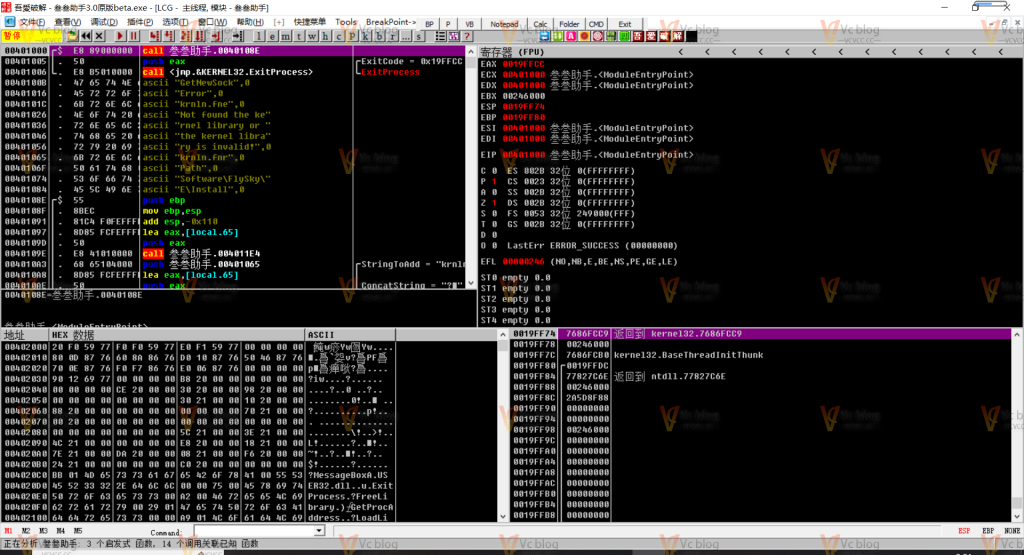在高并发Linux服务器环境中,”Too many open files”错误是导致服务崩溃的常见原因。本文通过真实的线上故障案例,详细解析文件描述符泄漏的定位方法、即时恢复方案和长效预防机制,提供从进程级诊断到系统级优化的完整防护体系。
![图片[1]-Linux文件描述符泄漏:从服务崩溃到系统级防护的完整解决方案-Vc博客](https://blogimg.vcvcc.cc/2025/10/20251031152648454.jpg?imageView2/0/format/webp/q/75)
一、故障现场:突发的服务雪崩
某电商平台在促销活动期间,核心API服务突然出现大规模故障:
# 服务日志中的错误信息
tail -f /var/log/api-service/error.log
# 输出:
# java.io.IOException: Too many open files
# unable to create new native thread
# accept failed: 24
# 系统监控指标异常
cat /proc/sys/fs/file-nr
# 输出:1248000 0 800000
# 已分配文件描述符:1248000,达到系统上限二、紧急响应:快速恢复服务可用性
1. 即时诊断与临时解决方案
<strong>#!/bin/bash</strong>
# emergency_fd_leak_fix.sh
echo "=== 文件描述符泄漏紧急处理 ==="
# 1. 检查系统级文件描述符使用
echo "1. 系统级FD状态:"
echo "当前已打开文件数: $(cat /proc/sys/fs/file-nr | awk '{print $1}')"
echo "系统最大限制: $(cat /proc/sys/fs/file-max)"
# 2. 查找FD使用最多的进程
echo "2. FD使用Top10进程:"
ps -e -o pid,ppid,cmd,%mem,%cpu --sort=-%cpu | head -10 | while read line; do
pid=$(echo $line | awk '{print $1}')
if [ -d "/proc/$pid" ]; then
fd_count=$(ls /proc/$pid/fd <strong>2</strong>>/dev/null | wc -l)
echo "PID: $pid, FD数量: $fd_count, 命令: $(echo $line | cut -d' ' -f3-)"
fi
done
# 3. 临时增加限制
echo "3. 临时调整系统限制..."
echo 2000000 > /proc/sys/fs/file-max
echo 1000000 > /proc/sys/fs/nr_open
# 4. 重启异常进程
echo "4. 重启高FD占用服务..."
for service in api-service order-service payment-service; do
if systemctl is-active --quiet $service; then
echo "重启服务: $service"
systemctl restart $service
fi
done2. 服务级连接限制调整
# 调整关键服务的文件描述符限制
cat > /etc/systemd/system/api-service.service.d/limits.conf << EOF
[Service]
LimitNOFILE=500000
LimitNPROC=100000
LimitMEMLOCK=infinity
EOF
systemctl daemon-reload
systemctl restart api-service三、深度诊断:定位泄漏根源
1. 进程级文件描述符分析
<strong>#!/bin/bash</strong>
# fd_leak_detector.sh
TARGET_PID="$1"
if [ -z "$TARGET_PID" ]; then
echo "使用方法: $0 <进程PID>"
exit 1
fi
echo "=== 文件描述符泄漏分析: PID $TARGET_PID ==="
echo "分析时间: $(date)"
# 1. 进程基本信息
echo "1. 进程信息:"
ps -p $TARGET_PID -o pid,ppid,user,cmd,%mem,%cpu
# 2. FD类型统计
echo "2. 文件描述符类型统计:"
ls -l /proc/$TARGET_PID/fd <strong>2</strong>>/dev/null | awk '
/->/ {
type = "未知"
if ($9 ~ /socket:/) type = "网络套接字"
else if ($9 ~ /pipe:/) type = "管道"
else if ($9 ~ /\/dev\//) type = "设备文件"
else if ($9 ~ /\.log$|\.txt$/) type = "日志文件"
else if ($9 ~ /^\/[a-z]/) type = "普通文件"
count[type]++
}
END {
for (t in count) printf " %s: %d个\n", t, count[t]
}'
# 3. 检查FD泄漏模式
echo "3. 泄漏模式分析:"
# 检查是否有关闭失败的FD
lsof -p $TARGET_PID | grep -i "deleted" | head -10
# 4. 监控FD增长趋势
echo "4. FD增长监控:"
for i in {1..6}; do
current_fd=$(ls /proc/$TARGET_PID/fd <strong>2</strong>>/dev/null | wc -l)
echo " $(date +%H:%M:%S) - FD数量: $current_fd"
sleep 10
done2. 代码级泄漏点定位
// Java应用中的典型FD泄漏模式
public class ConnectionManager {
private static List<Socket> connectionPool = new ArrayList<>();
// 错误的实现:连接从未关闭
public void createConnection(String host, int port) throws IOException {
Socket socket = new Socket(host, port);
connectionPool.add(socket);
// 缺失: socket.close()
}
// 正确的实现:使用try-with-resources
public void safeCreateConnection(String host, int port) {
try (Socket socket = new Socket(host, port)) {
// 使用socket进行操作
processData(socket);
} catch (IOException e) {
logger.error("连接失败", e);
}
}
}四、系统级防护方案
1. 内核参数优化
<strong>#!/bin/bash</strong>
# system_fd_optimization.sh
echo "配置系统级文件描述符防护..."
# 备份原有配置
cp /etc/sysctl.conf /etc/sysctl.conf.backup.$(date +%Y%m%d)
# 优化内核参数
cat >> /etc/sysctl.conf << EOF
# 文件描述符优化
fs.file-max = 1000000
fs.nr_open = 1000000
# 网络连接优化
net.core.somaxconn = 65535
net.ipv4.tcp_max_syn_backlog = 65535
net.core.netdev_max_backlog = 2000
# 内存与IO优化
vm.swappiness = 10
vm.vfs_cache_pressure = 50
EOF
# 应用配置
sysctl -p
echo "系统级优化完成"2. 用户级限制配置
# 配置全局用户限制
cat >> /etc/security/limits.conf << EOF
# 应用用户限制
appuser soft nofile 50000
appuser hard nofile 100000
appuser soft nproc 10000
appuser hard nproc 20000
# 系统服务限制
root soft nofile 100000
root hard nofile 200000
EOF五、应用级预防措施
1. 资源管理最佳实践
#!/usr/bin/env python3
# resource_manager.py
import psutil
import logging
from contextlib import contextmanager
class ResourceMonitor:
def __init__(self, pid, threshold=0.8):
self.pid = pid
self.threshold = threshold
self.process = psutil.Process(pid)
def check_fd_usage(self):
"""检查文件描述符使用情况"""
try:
open_files = self.process.open_files()
fd_count = self.process.num_fds()
soft_limit, hard_limit = self.process.rlimit(psutil.RLIMIT_NOFILE)
usage_ratio = fd_count / soft_limit
if usage_ratio > self.threshold:
logging.warning(
f"FD使用率过高: {fd_count}/{soft_limit} "
f"({usage_ratio:.1%})"
)
return False
return True
except psutil.AccessDenied:
logging.error("无法访问进程资源信息")
return False
@contextmanager
def managed_resource(resource_type, resource_id):
"""资源管理上下文管理器"""
resource = None
try:
# 获取资源
if resource_type == "file":
resource = open(resource_id, 'r')
elif resource_type == "socket":
# 套接字创建逻辑
pass
yield resource
except Exception as e:
logging.error(f"资源处理失败: {e}")
raise
finally:
# 确保资源释放
if resource:
try:
resource.close()
except Exception as e:
logging.error(f"资源关闭失败: {e}")2. 自动化监控告警系统
<strong>#!/bin/bash</strong>
# fd_monitor_daemon.sh
# 监控配置
CHECK_INTERVAL=60
ALERT_THRESHOLD=0.8
ALERT_EMAIL="admin@company.com"
monitor_process_fd() {
local pid=$1
local process_name=$2
while true; do
if [ ! -d "/proc/$pid" ]; then
echo "进程 $process_name (PID: $pid) 已退出"
break
fi
# 获取FD使用情况
fd_current=$(ls /proc/$pid/fd <strong>2</strong>>/dev/null | wc -l)
fd_limit=$(cat /proc/$pid/limits <strong>2</strong>>/dev/null | grep "open files" | awk '{print $5}')
if [ -n "$fd_limit" ] && [ "$fd_limit" -gt 0 ]; then
usage_ratio=$(echo "scale=2; $fd_current / $fd_limit" | bc)
if (( $(echo "$usage_ratio > $ALERT_THRESHOLD" | bc -l) )); then
# 触发告警
alert_message="警告: 进程 $process_name (PID: $pid) FD使用率 ${usage_ratio}%"
echo "$alert_message" | mail -s "FD使用率告警" "$ALERT_EMAIL"
# 记录详细状态
echo "$(date): $alert_message" >> /var/log/fd_monitor.log
ls -l /proc/$pid/fd >> /var/log/fd_monitor_detail_$(date +%Y%m%d).log
fi
fi
sleep $CHECK_INTERVAL
done
}
# 主监控循环
while true; do
# 监控关键服务进程
for service in nginx mysql redis api-service; do
pid=$(pgrep -f "$service")
if [ -n "$pid" ]; then
monitor_process_fd "$pid" "$service" &
fi
done
wait
sleep 300 # 5分钟后重新检查进程列表
done六、真实案例:线上环境FD泄漏解决
1. 故障背景
某微服务架构的电商平台,在促销期间订单服务频繁重启,日志显示”Too many open files”错误。
2. 排查过程
# 使用诊断脚本分析
./fd_leak_detector.sh $(pgrep -f order-service)
# 发现大量ESTABLISHED状态的Socket连接未关闭
ls -l /proc/$(pgrep -f order-service)/fd | grep socket | wc -l
# 输出:485003. 根本原因
发现HTTP客户端连接池配置错误,连接创建后未正确释放:
# 错误的连接池配置
http-client:
pool:
max-total: 1000
default-max-per-route: 100
# 缺失连接超时和回收配置4. 解决方案
# 修复后的连接池配置
http-client:
pool:
max-total: 200
default-max-per-route: 20
validate-after-inactivity: 2000
time-to-live: 30000
evict-idle-connections: <strong>true</strong>【总结】
文件描述符泄漏是Linux高并发环境中的典型问题,需要建立从监控预警到根本解决的完整防护体系。通过实时监控、资源管理最佳实践和系统级优化,可以有效预防和快速解决FD泄漏问题。关键在于建立完善的资源生命周期管理和异常检测机制。
© 版权声明
THE END

















暂无评论内容